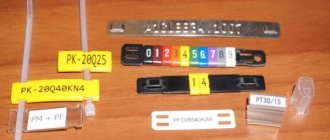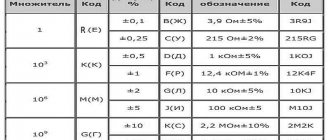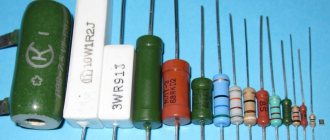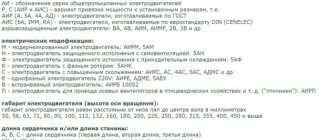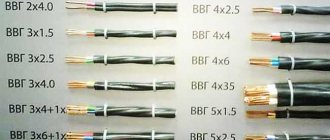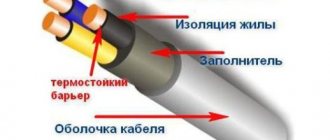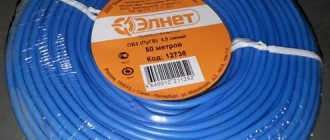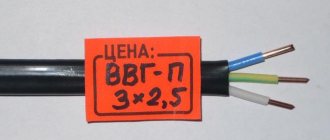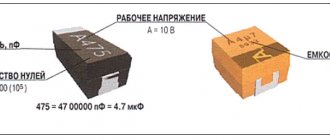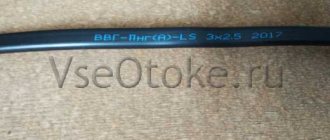Leadless design (SMD) resistors, like other components, require markings. From it you can get information about the resistor value and its accuracy. But in the case of SMD components, dimensions become a problem. It is impossible to apply a complete alphanumeric designation in a limited space. Marking in the form of color stripes is also not a solution - there is also not enough space to place the required number of tags. Determining the first familiarity location (where to start reading from) will also become a problem: a thickened line or a marking shifted to one side will also require additional space. Therefore, a special notation system has been adopted for leadless elements.
Three-digit resistor numbering with tolerances of 2%, 5% and 10%
If there are three symbols on the body of the device, this means that the resistor has an accuracy of 2% to 10%. There are two options for three-digit marking of electronic components - completely digital and alphanumeric designation.
Three digits
In most cases, the marking consists of three digits XYZ. They represent resistance in the form XY⋅10Z. An example of such a designation is 332. The first two digits mean 33 Ohms, and the third is the power to which the number 10 must be raised and then multiplied by 33. Simply this means the number of zeros that must be added to the right of the first two numbers. In this case, the marking means 3300 Ohm = 3.3 kOhm. If the third digit is zero, then there is no need to add anything (10=1). So, marking 100 means 10 Ohms (10×1). There are no decimal factors less than one (0.1 or 0.01) in this system.
Dimensions of SMD parts housings
SMD resistors
| TYPE: | Type Explanation: | |||||
| S.R. | Resistor Chip Resistor chip | |||||
| Size (inches) | Size(mm) | Component Thickness | Tape width | Component pitch in the ribbon | Quantity in standard packaging (180 mm/7 inches) paper tape | Qty per standard package (180 mm/7 inches) plastic tape |
| 01005 | 0402 | 0.12 mm ± 0.02 | 8 mm | 2 mm | 20000 | – |
| 0201 | 0603 | 0.23 mm ± 0.03 | 8 mm | 2 mm | 15000 | – |
| 0402 | 1005 | 0.35 mm ± 0.05 | 8 mm | 2 mm | 10000 | – |
| 0603 | 1608 | 0.45 mm ± 0.1 | 8 mm | 4 mm | 5000 | – |
| 0805 | 2012 | 0.55 mm ± 0.1 | 8 mm | 4 mm | 5000 | – |
| 1206 | 3216 | 0.55 mm ± 0.15 | 8 mm | 4 mm | 5000 | – |
| 1210 | 3225 | 0.55 mm ± 0.15 | 8 mm | 4 mm | 5000 | 4000 |
| 2010 | 5025 | 0.55 mm ± 0.15 | 8/12 mm | 4/8 mm | – | 4000 |
| 2512 | 6332 | 0.55 mm ± 0.15 | 12 mm | 4/8 mm | – | 4000/2000 |
| TYPE: | Type Explanation: | ||||
| SRM | Melf Resistor Melf resistor (round) | ||||
| Size (inches) | Name | Component size | Tape width | Component pitch in the ribbon | Qty per standard package (180 mm/7 inches) plastic tape |
| 0604 | – | 1.6 mm X 1.0 mm | 8 mm | 4 mm | 3000 |
| 0805 | Micro | 2.2 mm X 1.1 mm | 8 mm | 4 mm | 3000 |
| 1206 | Mini | 3.2 mm X 1.6 mm | 8 mm | 4 mm | 3000 |
| 1406 | Mini | 3.5 mm X 1.4 mm | 8 mm | 4 mm | 3000 |
| 2308 | Melf | 5.9 mm X 2.2 mm | 12 mm | 4 mm | 1500 |
SMD capacitors
| TYPE: | Type Explanation: | |||||
| S.C. | Ceramic Chip Capacitor Ceramic chip capacitor | |||||
| Size (inches) | Size(mm) | Component Thickness | Tape width | Component pitch in the ribbon | Quantity in standard packaging (180 mm/7 inches) paper tape | Qty per standard package (180 mm/7 inches) plastic tape |
| 01005 | 0402 | 0.2 mm ± 0.03 | 8 mm | 2 mm | 20000 | – |
| 0201 | 0603 | 0.3 mm ± 0.03 | 8 mm | 2 mm | 15000 | – |
| 0402 | 1005 | 0.5 mm ± 0.1 | 8 mm | 2 mm | 10000 | – |
| 0603 | 1608 | 0.8 mm ± 0.1 | 8 mm | 4 mm | 4000 | – |
| 0805 | 2012 | 0.6 – 1.25 mm | 8 mm | 4 mm | 4000 | 3000 |
| 1206 | 3216 | 0.6 – 1.25 mm | 8 mm | 4 mm | 4000 | 3000 |
| 1210 | 3225 | 1.25 mm – 1.5 mm | 8 mm | 4 mm | – | 3000 |
| 1812 | 4532 | 2 mm (Max.) | 12 mm | 8 mm | – | 1000 |
| 2225 | 5664 | 2 mm (Max.) | 12 mm | 8 mm | – | 1000 |
Tantalum capacitors SMD
| TYPE: | Type Explanation: | |||||
| SD | Molded Tantalum Tantalum capacitor (polar component) | |||||
| Size (inches) | Code | Component Thickness | Component size | Tape width | Component pitch in the ribbon | Qty per standard package (180 mm/7 inches) plastic tape |
| 3216 | A | 1.6 mm | 3.2 mm X 1.6 mm | 8 mm | 4 mm | 2000 |
| 3528 | B | 1.9 mm | 3.5 mm X 2.8 mm | 8 mm | 4 mm | 2000 |
| 6032 | C | 2.5 mm | 6.0 mm X 3.2 mm | 12 mm | 8 mm | 500 |
| 7343 | D | 2.8 mm | 7.3 mm X 4.3 mm | 12 mm | 8 mm | 500 |
| 1608 | J | 0.8 mm | 1.6 mm X 0.8 mm | 8 mm | 4 mm | 4000 |
| 2012 | P/R | 1.2 mm | 2.0 mm X 1.2 mm | 8 mm | 4 mm | 2500/3000 |
Electrolytic capacitors SMD
| TYPE: | Type Explanation: | ||||
| S.E. | Aluminum Capacitor Aluminum capacitor (polar component) | ||||
| Case diameter | Case height | Tape width | Component pitch in the ribbon | Qty per standard package (180 mm/7 inches) plastic tape | Qty per standard pack (330 mm/13 inches) plastic tape |
| 3 mm | 5.5 mm | 12 mm | 8 mm | 100 | 2000 |
| 4 mm | 5.5 mm | 12 mm | 8 mm | 100 | 2000 |
| 5 mm | 5.5 mm | 12 mm | 12 mm | 100 | 1000 |
| 6.3 mm | 5.5 mm | 16 mm | 12 mm | 100 | 1000 |
| 8 mm | 6 mm | 16 mm | 12 mm | 100 | 1000 |
| 8 mm | 10 mm | 24 mm | 16 mm | 100 | 500 |
| 10 mm | 10 mm | 24 mm | 16 mm | 100 | 300 – 500 |
| 10 mm | 14 – 22 mm | 32 mm | 20 mm | – | 250 – 300 |
| 12.5 mm | 14 mm | 32 mm | 24 mm | – | 200 – 250 |
| 12.5 mm | 17 mm | 32 mm | 24 mm | – | 150 – 200 |
| 12.5 mm | 22 mm | 32 mm | 24 mm | – | 125 – 150 |
| 16 mm | 17 mm | 44 mm | 28 mm | – | 125 – 150 |
| 16 mm | 22 mm | 44 mm | 28 mm | – | 75 – 100 |
| 18 mm | 17 mm | 44 mm | 32 mm | – | 125 – 150 |
| 18 mm | 22 mm | 44 mm | 32 mm | – | 75 – 100 |
| 20 mm | 17 mm | 44 mm | 36 mm | – | 50 |
SMD transistors
| TYPE: | Type Explanation: | |||||||
| SOT | SOT Transistor SOT transistor | |||||||
| Type of shell | Number of pins | Tape width | Component pitch in the ribbon | Case size A (mm) | Case size B (mm) | Case size S (mm) | Case height H (mm) | Qty per standard package (180 mm/7 inches) plastic tape |
| SOT723 | 3 | 8 mm | 4 mm | 1.2 | 0.8 | 1.2 | 0.5 | 8000 |
| SOT346 | 3 | 8 mm | 4 mm | 2.9 | 1.6 | 2.8 | 1.1 | 3000 |
| SOT323 | 3 | 8 mm | 4 mm | 2.0 | 1.25 | 2.1 | 0.9 | 3000 |
| SOT416 | 3 | 8 mm | 4 mm | 1.6 | 0.8 | 1.6 | 0.7 | 3000 |
| SOT523F | 3 | 8 mm | 4 mm | 1.6 | 0.8 | 1.6 | 0.7 | 3000 |
| SOT23 | 3 | 8 mm | 4 mm | 2.9 | 1.3 | 2.4 | 0.95 | 3000 |
| SOT23-5 | 5 | 8 mm | 4 mm | 2.9 | 1.6 | 2.8 | 1.1 | 3000 |
| SOT23-6 | 6 | 8 mm | 4 mm | 2.9 | 1.6 | 2.8 | 1.1 | 3000 |
| SOT89 | 3 | 12 mm | 8 mm | 4.5 | 2.5 | 4.0 | 1.5 | 1000 |
| SOT143 | 4 | 8 mm | 4 mm | 2.9 | 1.6 | 2.8 | 0.95 | 3000 |
| SOT223 | 3 | 16 mm | 8 mm | 6.5 | 3.6 | 7.0 | 1.6 | 2500 |
| SOT323 | 3 | 8 mm | 4 mm | 2.0 | 1.25 | 2.1 | 0.9 | 3000 |
| SOT343 | 4 | 8 mm | 4 mm | 2.0 | 1.25 | 2.1 | 0.9 | 3000 |
| SOT353 | 5 | 8 mm | 4 mm | 2.0 | 1.25 | 2.1 | 0.9 | 3000 |
| SOT363 | 6 | 8 mm | 4 mm | 2.0 | 1.25 | 2.1 | 0.9 | 3000 |
| SOT23-8 | 8 | 8 mm | 4 mm | 2.9 | 1.6 | 2.9 | 1.2 | 3000 |
Power transistors SMD
| TYPE: | Type Explanation: | |||||||
| DPAK | DPAK Transistor DPAK Transistor | |||||||
| Type of shell | Number of pins | Tape width | Component pitch in the ribbon | Case size L (mm) | Case size W (mm) | Case height H (mm) | Case size S (mm) | Qty per standard pack (330 mm/13 inches) plastic tape |
| DPAK | 3 | 16 mm | 8 mm | 6 | 6.5 | 2.3 | 10 | 2500 |
| D2PAK | 3 | 24 mm | 16 mm | 9.2 | 10 | 4.4 | 15 | 500 – 800 |
| D2PAK-5 | 5 | 24 mm | 16 mm | 9.2 | 10 | 4.4 | 15 | 500 – 800 |
| D2PAK-7 | 7 | 24 mm | 16 mm | 9.2 | 10 | 4.4 | 15 | 500 – 800 |
| D3PAK | 3 | 24 mm | 24 mm | 14 | 16 | 4.7 | 18.8 | 500 |
MELF SMD diodes
| TYPE: | Type Explanation: | |||
| SOD | SOD, SM, Melf Diode/Rectifier SOD, SM, Melf diodes (round) | |||
| Component type | Component size (diameter X length) | Tape width | Component pitch in the ribbon | Qty per standard package (180 mm/7 inches) plastic tape |
| MiniMELF/SOD-80 (LL34) | 1.6 mm X 3.5 mm | 8 mm | 4 mm | 2500 |
| MELF (LL35/LL41) | 2.5 mm X 5.0 mm | 12 mm | 4 mm | 1500 |
| MELF (SM1) | 2.5 mm X 5.0 mm | 12 mm | 4 mm | 1750 |
SOD SMD diodes
| TYPE: | Type Explanation: | |||||||
| S.M. | Rectangular Diode Gull Wing Lead | |||||||
| Type of shell | Tape width | Component pitch in the ribbon | Case size L (mm) | Case size W (mm) | Case height H (mm) | Case size S (mm) | Case size B (mm) | Qty per standard package (170 mm/7 inches) plastic tape |
| SOD923 | 8 mm | 2 mm | 0.8 | 0.6 | 0.4 | 1.0 | 0.2 | 8000 |
| SOD723 | 8 mm | 2 mm | 1.0 | 0.6 | 0.5 | 1.4 | 0.3 | 8000 |
| SOD523 | 8 mm | 4 mm | 1.2 | 0.8 | 0.6 | 1.6 | 0.3 | 3000 |
| SOD323 | 8 mm | 4 mm | 1.7 | 1.25 | 0.7 | 2.5 | 0.3 | 3000 |
| SOD123 | 8 mm | 4 mm | 2.7 | 1.5 | 1.3 | 3.6 | 0.7 | 3000 |
| DO215AC | 12 mm | 4 mm | 4.3 | 2.6 | 2.2 | 6.1 | 1.4 | 1800 |
| DO215AA | 12 mm | 8 mm | 4.3 | 3.6 | 2.3 | 6.2 | 2.0 | 1000 |
| DO215AB | 16 mm | 8 mm | 7.0 | 6.0 | 2.3 | 1 0 | 3.0 | 900 |
SM SMD Diodes
| TYPE: | Type Explanation: | |||||||
| S.M. | Rectangular Diode C-Bend Lead (Modified J-Lead) | |||||||
| Type of shell | Tape width | Component pitch in the ribbon | Case size L (mm) | Case size W (mm) | Case height H (mm) | Case size S (mm) | Case size B (mm) | Qty per standard package (170 mm/7 inches) plastic tape |
| S.M.A.J. | 12 mm | 4 mm | 4.3 | 2.6 | 2.2 | 5.0 | 1.5 | 1800 |
| SMBJ | 12 mm | 8 mm | 4.3 | 3.6 | 2.3 | 5.4 | 2.0 | 750 |
| SMCJ | 16 mm | 8 mm | 7.0 | 6.0 | 2.3 | 8.0 | 3.0 | 850 |
Marking of SMD resistors according to EIA-96
The four-digit designation of resistor parameters is not the optimal method. Still, there is not enough space for four characters on small-sized cases. Therefore, for devices with an accuracy of 1% for form factors below 0805, a different marking system is used, consisting of two numbers and an alphabetic symbol. This designation is introduced by the EIA -96 , according to which two numbers indicate the nominal value in ohms, and the letter indicates the multiplier.
Table of codes and resistor marking values
In the EIA-96 standard, there is no direct correspondence between the marking numbers and the denomination. The actual resistance value is associated with a code. To determine the resistance value, you need to refer to the table:
Table 1. Table of codes and resistor marking values according to EIA-96.
So, code 20 corresponds to a value of 158 Ohms, and code 69 - 511. Obviously, it is very difficult to remember the correspondence between the code and the nominal value. Therefore, it is recommended to use a table or an online calculator.
Multiplier table
The multiplier table is smaller, but also non-obvious and difficult to remember:
Methods for determining resistor resistance
If there is no alphanumeric marking, you can use one of the following methods:
- The simplest method is to determine the denomination from the documentation. This is easiest to do if the part is purchased separately and has an accompanying document. If a resistor is part of an electrical apparatus, then its characteristics are indicated on the general electrical diagram either directly next to it (to the right or below) or below in the specification.
- If the resistor is a separate part, then its resistance can be measured with an ohmmeter or multimeter.
- It is possible to accurately identify a part contained in the device only after it has been desoldered.
Examples of decoding alphanumeric markings of SMD resistors
To determine the resistor parameter, it is not necessary to memorize tables of values. There are many online calculators on the Internet, and many offline programs are also available for download. But if you understand the principles of marking, it is possible to determine the values of resistance and accuracy without resorting to reference books; after a little training, this is obtained at first glance. To consolidate your understanding of the basics, you need to look at several practical examples.
Resistors 101, 102, 103, 104
In all these examples, the numerical value of the resistance is the same, equal to 10, but the multipliers in each case are different:
- 101 - 10 Ohms must be multiplied by 101, that is, by 10, or added to the value of one 0 - the total will be 100 Ohms;
- 102 - 10 Ohms must be multiplied by 102, that is, by 100, or two zeros must be added to the value - you get 1000 Ohms (= 1 kOhm);
- 103 - 10 Ohms must be multiplied by 103, that is, by 1000, or three zeros must be added to the value - you get 10,000 Ohms (= 10 kOhms);
- 104 - 10 Ohms must be multiplied by 104, that is, by 10,000, or four zeros must be added to the value - you get 100,000 Ohms (= 100 kOhms).
It is easy to remember that for a three-character encoding, the last digit 3 indicates kilo-ohms, and 6 - mega-ohms - this will further facilitate visual reading of the marking.
Resistors 1001, 1002, 2001
If there are 4 digits on the body of an electronic component, this means that its accuracy is at least 1%. And the denomination also consists of a mantissa and a multiplier, which is specified by the last symbol:
- 1001 - 100 Ohms must be multiplied by 101, that is, by 10, which is equivalent to adding one zero to the mantissa - the result will be 1000 Ohms (1 kOhm);
- 1002 – the mantissa is also equal to 100 Ohm, but the multiplier is equal to 102=100 (two zeros must be added), and the nominal value will be equal to 10000 Ohm=10 kOhm;
- 2001 - in this case, 200 Ohms must be multiplied by 101 = 10, the nominal value is 2000 Ohms = 2 kOhms.
Types of SMD capacitors
Every radio amateur needs to understand the types of capacitors mounted using the surface-mount method. Such products may differ not only in capacity, but also in voltage, so ignoring the conditions for using parts can lead to their failure.
Electrolytic components
Electrolytic SMD capacitors do not differ fundamentally from standard products. Such electronic components most often take the form of barrels, in which a thin metal rolled into a cylinder is located under an aluminum housing, and a solid or liquid electrolyte is located between it.
Electrolytic SMD capacitors
The main difference between such a part and a standard electrolytic cell is that its contacts are mounted on a flat dielectric substrate. Such products are very reliable in operation, especially convenient when it is necessary to install a new product with minimal time investment.
In addition, during soldering the product does not overheat, which is very important for electrolytic capacitors
Ceramic components
In ceramic elements, porcelain or similar inorganic materials are used as a dielectric. The main advantage of such products is their resistance to high temperatures and the ability to produce products of extremely small sizes.
Important! SMD ceramic capacitors are also installed by soldering onto a printed circuit board. Visually, such an element, as a rule, resembles a small brick to which contact pads are soldered at the ends
Visually, such an element, as a rule, resembles a small brick to which contact pads are soldered at the ends
Visually, such an element, as a rule, resembles a small brick to which contact pads are soldered at the ends.
Ceramic SMD capacitors
Unlike radio components of standard sizes, SMD elements of small size are first glued to the board, and only then the leads are soldered. In production, ceramic products of this type are installed by special automatic machines.
Marking of tantalum SMD capacitors
Tantalum SMD capacitors are resistant to increased mechanical loads. Such products can also be made in the form of a small parallelepiped, to which contact leads are soldered on the sides. Tantalum is a very durable metal with high ductility. Foil made of this material can have a thickness of hundredths of a millimeter.
For your information! Due to the presence of certain physical properties based on tantalum, it is possible to produce radio components of the highest precision.
Tantalum capacitors
Tantalum capacitors, as a rule, have small housing sizes, so it is not always possible to apply full markings to products made in an “A” size housing. Knowing the designation features of radio components of this type, you can easily determine the rating of the product. The maximum permissible voltage in volts for tantalum products is indicated in Latin letters:
- G - 4;
- J - 6.3;
- A - 10;
- C - 16;
- D - 20;
- E - 25;
- V - 35;
- T - 50.
Note! The capacity of the products is indicated in microfarads after the letter “μ”, and the positive contact is indicated with a thick line
Coding table for planar SMD parts
The first pairs of digits of the SMD component marking are indicated. You need to click on them, after which a page will open with another table, which contains combinations of other symbols. A brief description of the functions and parameters is also provided.
| 00 | 01 | 02 | 03 | 04 | 05 | 06 | 07 | 08 | 09 | 0A | 0B | 0C | 0D | 0E | 0F | 0G | 0H | 0I | 0J | 0K | 0L | 0M | 0N | 0P | 0Q | 0R | 0S | 0T | 0U | 0V | 0W | 0X | 0Y | 0Z |
| 10 | 11 | 12 | 13 | 14 | 15 | 16 | 17 | 18 | 19 | 1A | 1B | 1C | 1D | 1E | 1F | 1G | 1H | 1I | 1J | 1K | 1L | 1M | 1N | 1P | 1Q | 1R | 1S | 1T | 1U | 1V | 1W | 1X | 1Y | 1Z |
| 20 | 21 | 22 | 23 | 24 | 25 | 26 | 27 | 28 | 29 | 2A | 2B | 2C | 2D | 2E | 2F | 2G | 2H | 2I | 2J | 2K | 2L | 2M | 2N | 2P | 2Q | 2R | 2S | 2T | 2U | 2V | 2W | 2X | 2Y | 2Z |
| 30 | 31 | 32 | 33 | 34 | 35 | 36 | 37 | 38 | 39 | 3A | 3B | 3C | 3D | 3E | 3F | 3G | 3H | 3I | 3J | 3K | 3L | 3M | 3N | 3P | 3Q | 3R | 3S | 3T | 3U | 3V | 3W | 3X | 3Y | 3Z |
| 40 | 41 | 42 | 43 | 44 | 45 | 46 | 47 | 48 | 49 | 4A | 4B | 4C | 4D | 4E | 4F | 4G | 4H | 4I | 4J | 4K | 4L | 4M | 4N | 4P | 4Q | 4R | 4S | 4T | 4U | 4V | 4W | 4X | 4Y | 4Z |
| 50 | 51 | 52 | 53 | 54 | 55 | 56 | 57 | 58 | 59 | 5A | 5B | 5C | 5D | 5E | 5F | 5G | 5H | 5I | 5J | 5K | 5L | 5M | 5N | 5P | 5Q | 5R | 5S | 5T | 5U | 5V | 5W | 5X | 5Y | 5Z |
| 60 | 61 | 62 | 63 | 64 | 65 | 66 | 67 | 68 | 69 | 6A | 6B | 6C | 6D | 6E | 6F | 6G | 6H | 6I | 6J | 6K | 6L | 6M | 6N | 6P | 6Q | 6R | 6S | 6T | 6U | 6V | 6W | 6X | 6Y | 6Z |
| 70 | 71 | 72 | 73 | 74 | 75 | 76 | 77 | 78 | 79 | 7A | 7B | 7C | 7D | 7E | 7F | 7G | 7H | 7I | 7J | 7K | 7L | 7M | 7N | 7P | 7Q | 7R | 7S | 7T | 7U | 7V | 7W | 7X | 7Y | 7Z |
| 80 | 81 | 82 | 83 | 84 | 85 | 86 | 87 | 88 | 89 | 8A | 8B | 8C | 8D | 8E | 8F | 8G | 8H | 8I | 8J | 8K | 8L | 8M | 8N | 8P | 8Q | 8R | 8S | 8T | 8U | 8V | 8W | 8X | 8Y | 8Z |
| 90 | 91 | 92 | 93 | 94 | 95 | 96 | 97 | 98 | 99 | 9A | 9B | 9C | 9D | 9E | 9F | 9G | 9H | 9I | 9J | 9K | 9L | 9M | 9N | 9P | 9Q | 9R | 9S | 9T | 9U | 9V | 9W | 9X | 9Y | 9Z |
| A0 | A1 | A2 | A3 | A4 | A5 | A6 | A7 | A8 | A9 | A.A. | AB | A.C. | AD | A.E. | A.F. | A.G. | A.H. | A.I. | A.J. | A.K. | AL | A.M. | AN | AP | AQ | AR | AS | AT | AU | AV | A.W. | AX | AY | AZ |
| B0 | B1 | B2 | B3 | B4 | B5 | B6 | B7 | B8 | B9 | B.A. | BB | B.C. | BD | BE | B.F. | B.G. | B.H. | B.I. | B.J. | B.K. | B.L. | B.M. | BN | B.P. | BQ | BR | B.S. | BT | B.U. | B.V. | B.W. | BX | BY | BZ |
| C0 | C1 | C2 | C3 | C4 | C5 | C6 | C7 | C8 | C9 | C.A. | C.B. | CC | CD | C.E. | CF | C.G. | CH | C.I. | C.J. | CK | C.L. | C.M. | CN | C.P. | C.Q. | CR | C.S. | C.T. | C.U. | CV | CW | CX | C.Y. | CZ |
| D0 | D1 | D2 | D3 | D4 | D5 | D6 | D7 | D8 | D9 | D.A. | D.B. | DC | DD | DE | DF | DG | D.H. | D.I. | DJ | DK | D.L. | DM | DN | D.P. | DQ | D.R. | D.S. | D.T. | D.U. | D.V. | DW | DX | DY | DZ |
| E0 | E1 | E2 | E3 | E4 | E5 | E6 | E7 | E8 | E9 | E.A. | E.B. | E.C. | ED | E.E. | E.F. | E.G. | E.H. | EI | EJ | E.K. | EL | E.M. | EN | E.P. | EQ | ER | ES | ET | EU | EV | E.W. | EX | EY | EZ |
| F0 | F1 | F2 | F3 | F4 | F5 | F6 | F7 | F8 | F9 | F.A. | FB | F.C. | FD | F.E. | FF | FG | FH | FI | F.J. | FK | FL | FM | FN | FP | FQ | FR | FS | F.T. | F.U. | F.V. | FW | FX | FY | FZ |
| G0 | G1 | G2 | G3 | G4 | G5 | G6 | G7 | G8 | G9 | GA | G.B. | G.C. | G.D. | G.E. | GF | GG | G.H. | G.I. | G.J. | GK | G.L. | G.M. | GN | G.P. | GQ | GR | G.S. | GT | G.U. | G.V. | G.W. | GX | G.Y. | GZ |
| H0 | H1 | H2 | H3 | H4 | H5 | H6 | H7 | H8 | H9 | H.A. | HB | HC | HD | HE | HF | HG | HH | HI | H.J. | H.K. | H.L. | H.M. | HN | HP | HQ | HR | H.S. | HT | HU | H.V. | HW | HX | HY | HZ |
| I0 | I1 | I2 | I3 | I4 | I5 | I6 | I7 | I8 | I9 | I.A. | I.B. | IC | ID | I.E. | IF | I.G. | IH | II | IJ | IK | IL | I.M. | IN | IP | IQ | IR | IS | IT | IU | IV | IW | IX | IY | IZ |
| J0 | J1 | J2 | J3 | J4 | J5 | J6 | J7 | J8 | J9 | JA | JB | JC | JD | JE | JF | JG | JH | JI | JJ | JK | JL | J.M. | JN | J.P. | J.Q. | JR | JS | JT | J.U. | JV | JW | JX | JY | JZ |
| K0 | K1 | K2 | K3 | K4 | K5 | K6 | K7 | K8 | K9 | K.A. | K.B. | KC | KD | KE | KF | KG | KH | KI | KJ | KK | KL | K.M. | KN | KP | KQ | KR | KS | KT | KU | KV | KW | KX | KY | KZ |
| L0 | L1 | L2 | L3 | L4 | L5 | L6 | L7 | L8 | L9 | L.A. | LB | L.C. | LD | L.E. | LF | LG | L.H. | LI | L.J. | L.K. | LL | L.M. | LN | LP | L.Q. | LR | L.S. | LT | L.U. | LV | LW | LX | LY | LZ |
| M0 | M1 | M2 | M3 | M4 | M5 | M6 | M7 | M8 | M9 | M.A. | M.B. | M.C. | M.D. | M.E. | M.F. | MG | M.H. | MI | MJ | MK | M.L. | MM | MN | MP | MQ | M.R. | MS | M.T. | M.U. | MV | M.W. | MX | M.Y. | MZ |
| N0 | N1 | N2 | N3 | N4 | N5 | N6 | N7 | N8 | N9 | N.A. | N.B. | NC | ND | NE | NF | NG | N.H. | NI | NJ | N.K. | NL | N.M. | NN | NP | N.Q. | NR | N.S. | NT | NU | N.V. | NW | NX | NY | NZ |
| P0 | P1 | P2 | P3 | P4 | P5 | P6 | P7 | P8 | P9 | PA | P.B. | PC | P.D. | P.E. | PF | PG | PH | P.I. | P.J. | PK | P.L. | P.M. | PN | PP | PQ | PR | PS | P.T. | P.U. | PV | PW | PX | PY | PZ |
| Q0 | Q1 | Q2 | Q3 | Q4 | Q5 | Q6 | Q7 | Q8 | Q9 | QA | QB | QC | QD | QE | QF | QG | QH | QI | Q.J. | QK | QL | QM | QN | QP | QR | QS | QT | QU | QV | QW | QX | QY | QZ | |
| R0 | R1 | R2 | R3 | R4 | R5 | R6 | R7 | R8 | R9 | R.A. | R.B. | R.C. | R.D. | RE | RF | RG | RH | R.I. | R.J. | RK | R.L. | R.M. | RN | R.P. | RQ | R.R. | R.S. | RT | RU | RV | RW | RX | R.Y. | RZ |
| S0 | S1 | S2 | S3 | S4 | S5 | S6 | S7 | S8 | S9 | S.A. | S.B. | S.C. | SD | S.E. | SF | S.G. | SH | S.I. | S.J. | S.K. | SL | S.M. | SN | SP | S.Q. | S.R. | SS | ST | S.U. | SV | S.W. | SX | S.Y. | SZ |
| T0 | T1 | T2 | T3 | T4 | T5 | T6 | T7 | T8 | T9 | T.A. | TB | TC | T.D. | T.E. | TF | TG | T.H. | T.I. | T.J. | TK | TL | TM | TN | TP | T.Q. | TR | T.S. | TT | T.U. | TV | TW | TX | T.Y. | TZ |
| U0 | U1 | U2 | U3 | U4 | U5 | U6 | U7 | U8 | U9 | U.A. | UB | U.C. | UD | UE | U.F. | U.G. | UH | UI | U.J. | UK | UL | U.M. | UN | U.P. | UQ | UR | US | UT | UU | UV | U.W. | UX | UY | UZ |
| V0 | V1 | V2 | V3 | V4 | V5 | V6 | V7 | V8 | V9 | V.A. | VB | V.C. | V.D. | V.E. | VF | VG | VH | VI | V.J. | VK | VL | V.M. | VN | V.P. | VQ | VR | VS | VT | VU | V.V. | VW | VX | VY | VZ |
| W0 | W1 | W2 | W3 | W4 | W5 | W6 | W7 | W8 | W9 | W.A. | W.B. | W.C. | W.D. | WE | W.F. | W.G. | W.H. | WI | W.J. | W.K. | W.L. | W.M. | WN | W.P. | W.Q. | WR | W.S. | W.T. | W.U. | W.V. | WW | W.X. | W.Y. | WZ |
| X0 | X1 | X2 | X3 | X4 | X5 | X6 | X7 | X8 | X9 | XA | XB | XC | XD | XE | XF | XG | XH | XI | XJ | XK | XL | XM | XN | XP | XQ | XR | XS | XT | XU | XV | XW | XX | XY | XZ |
| Y0 | Y1 | Y2 | Y3 | Y4 | Y5 | Y6 | Y7 | Y8 | Y9 | YA | YB | YC | YD | YE | YF | YG | YH | YI | YJ | YK | YL | YM | YN | YP | YQ | YR | YS | YT | YU | YV | YW | YX | YY | YZ |
| Z0 | Z1 | Z2 | Z3 | Z4 | Z5 | Z6 | Z7 | Z8 | Z9 | ZA | ZB | ZC | ZD | ZE | ZF | ZG | ZH | ZI | ZJ | ZK | ZL | ZM | ZN | ZP | ZQ | ZR | ZS | ZT | ZU | ZV | ZW | ZX | ZY | ZZ |
Watch the video:
